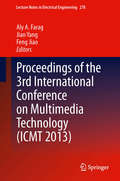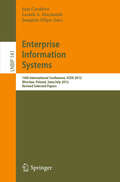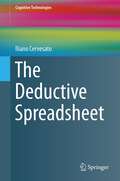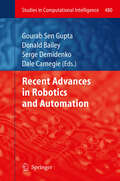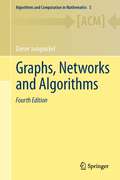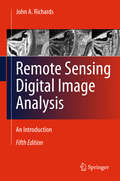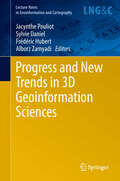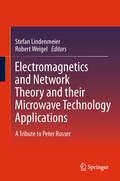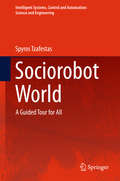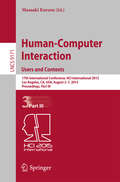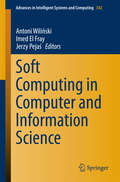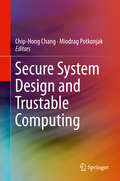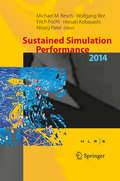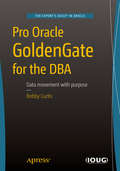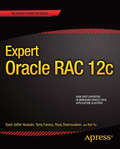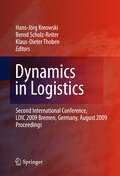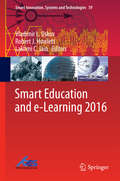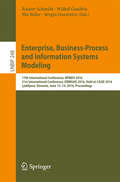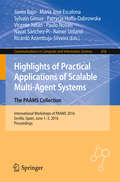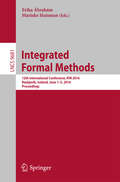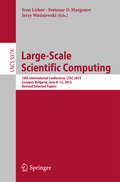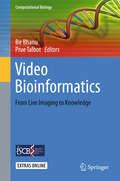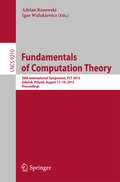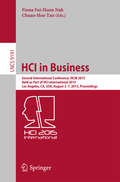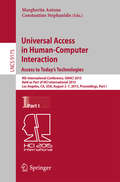- Table View
- List View
Proceedings of the 3rd International Conference on Multimedia Technology (ICMT #2013)
by Aly A. Farag Jian Yang Feng JiaoProceedings of the 3rd International Conference on Multimedia Technology (ICMT2013) focuses on both the theory and applications of multimedia technology. The recent advances, new research findings and applications in the fields of theoretical, experimental and applied image & video processing and multimedia technology presented at the conference are brought together in this book. It will serve as a valuable reference for scientists and engineers working in multimedia and related fields. Prof. Aly A. Farag works at the University of Louisville, USA; Prof. Jian Yang works at Tsinghua University, China; Dr. Feng Jiao works at Nanjing University of Information Science & Technology, China.
Enterprise Information Systems
by Leszek A. Maciaszek Joaquim Filipe José CordeiroThis book contains substantially extended and revised versions of the best papers from the 14th International Conference on Enterprise Information Systems (ICEIS 2012), held in Wroclaw, Poland, in June/July 2012. The 25 full and 3 invited papers included in this volume were carefully reviewed and selected from 299 submissions. They reflect state-of-the-art research work focusing mainly on real-world applications and highlighting the benefits of information systems and technology for industry and services, thus connecting academia with the world of real enterprises. The topics covered are: databases and information systems integration; artificial intelligence and decision support systems; information systems analysis and specification; software agents and internet computing; human-computer interaction; and enterprise architecture.
The Deductive Spreadsheet
by Iliano CervesatoThis book describes recent multidisciplinary research at the confluence of the fields of logic programming, database theory and human-computer interaction. The goal of this effort was to develop the basis of a deductive spreadsheet, a user productivity application that allows users without formal training in computer science to make decisions about generic data in the same simple way they currently use spreadsheets to make decisions about numerical data. The result is an elegant design supported by the most recent developments in the above disciplines. The first half of the book focuses on the deductive engine that underlies this application, the foundations that users do not see. After giving a mathematical model of traditional spreadsheet applications, we extend them with operators to perform a number of relational tasks, similar to the user view of a database but in a spreadsheet context. Expressing this extension in a logic programming framework is a natural step towards giving it powerful deductive capabilities. The second half of the book deals with the user interface, the part of the application with which the user actually interacts. We review the elements of the graphical user interface of traditional spreadsheet applications and describe practical methodologies for designing user interfaces borrowed from the field of cognitive psychology. We then propose a design that conservatively integrates mechanisms for a user to take advantage of the new deductive capabilities. This is followed by the results of some preliminary usability experiments. The book will appeal to researchers and practitioners in the various areas underlying this work. Researchers will not only find interesting new developments in their domains, but will also learn how to achieve a multidisciplinary focus. Practitioners will find fully developed solutions to numerous problems that are not easily solvable using traditional spreadsheet applications.
Recent Advances in Robotics and Automation
by Dale Carnegie Donald Bailey Gourab Sen Gupta Serge DemidenkoThere isn't a facet of human life that has not been touched and influenced by robots and automation. What makes robots and machines versatile is their computational intelligence. While modern intelligent sensors and powerful hardware capabilities have given a huge fillip to the growth of intelligent machines, the progress in the development of algorithms for smart interaction, collaboration and pro-activeness will result in the next quantum jump. This book deals with the recent advancements in design methodologies, algorithms and implementation techniques to incorporate intelligence in robots and automation systems. Several articles deal with navigation, localization and mapping of mobile robots, a problem that engineers and researchers are grappling with all the time. Fuzzy logic, neural networks and neuro-fuzzy based techniques for real world applications have been detailed in a few articles. This edited volume is targeted to present the latest state-of-the-art computational intelligence techniques in Robotics and Automation. It is a compilation of the extended versions of the very best papers selected from the many that were presented at the 5th International Conference on Automation, Robotics and Applications (ICARA 2011) which was held in Wellington, New Zealand from 6-8 December, 2011. Scientists and engineers who work with robots and automation systems will find this book very useful and stimulating.
Graphs, Networks and Algorithms
by Dieter JungnickelFrom the reviews of the previous editions ".... The book is a first class textbook and seems to be indispensable for everybody who has to teach combinatorial optimization. It is very helpful for students, teachers, and researchers in this area. The author finds a striking synthesis of nice and interesting mathematical results and practical applications. ... the author pays much attention to the inclusion of well-chosen exercises. The reader does not remain helpless; solutions or at least hints are given in the appendix. Except for some small basic mathematical and algorithmic knowledge the book is self-contained. ..." K.Engel, Mathematical Reviews 2002 The substantial development effort of this text, involving multiple editions and trailing in the context of various workshops, university courses and seminar series, clearly shows through in this new edition with its clear writing, good organisation, comprehensive coverage of essential theory, and well-chosen applications. The proofs of important results and the representation of key algorithms in a Pascal-like notation allow this book to be used in a high-level undergraduate or low-level graduate course on graph theory, combinatorial optimization or computer science algorithms. The well-worked solutions to exercises are a real bonus for self study by students. The book is highly recommended. P .B. Gibbons, Zentralblatt für Mathematik 2005 Once again, the new edition has been thoroughly revised. In particular, some further material has been added: more on NP-completeness (especially on dominating sets), a section on the Gallai-Edmonds structure theory for matchings, and about a dozen additional exercises - as always, with solutions. Moreover, the section on the 1-factor theorem has been completely rewritten: it now presents a short direct proof for the more general Berge-Tutte formula. Several recent research developments are discussed and quite a few references have been added.
Remote Sensing Digital Image Analysis
by John A. RichardsRemote Sensing Digital Image Analysis provides the non-specialist with an introduction to quantitative evaluation of satellite and aircraft derived remotely retrieved data. Since the first edition of the book there have been significant developments in the algorithms used for the processing and analysis of remote sensing imagery; nevertheless many of the fundamentals have substantially remained the same. This new edition presents material that has retained value since those early days, along with new techniques that can be incorporated into an operational framework for the analysis of remote sensing data. The book is designed as a teaching text for the senior undergraduate and postgraduate student, and as a fundamental treatment for those engaged in research using digital image processing in remote sensing. The presentation level is for the mathematical non-specialist. Since the very great number of operational users of remote sensing come from the earth sciences communities, the text is pitched at a level commensurate with their background. Each chapter covers the pros and cons of digital remotely sensed data, without detailed mathematical treatment of computer based algorithms, but in a manner conductive to an understanding of their capabilities and limitations. Problems conclude each chapter.
Progress and New Trends in 3D Geoinformation Sciences
by Alborz Zamyadi Frédéric Hubert Jacynthe Pouliot Sylvie DanielThe integration of the 3rd dimension in the production of spatial representation is largely recognized as a valuable approach to comprehend our reality, that is 3D. During the last decade developments in 3D Geoinformation (GI) system have made substantial progress. We are about to have a more complete spatial model and understanding of our planet in different scales. Hence, various communities and cities offer 3D landscape and 3D city models as valuable source and instrument for sustainable management of rural and urban resources. Also municipal utilities, real estate companies benefit from recent developments related to 3D applications. In order to present recent developments and to discuss future trends, academics and practitioners met at the 7th International Workshop on 3D Geoinformation. This book comprises a selection of evaluated, high quality papers that were presented at this workshop in May 2012. The topics focus explicitly on the last achievements (methods, algorithms, models, systems) with respect to 3D GeoInformation requirements. The book is aimed at decision makers and experts as well at students interested in the 3D component of geographical information science including GI engineers, computer scientists, photogrammetrists, land surveyors, urban planners, and mapping specialists.
Electromagnetics and Network Theory and their Microwave Technology Applications
by Robert Weigel Stefan LindenmeierThis volume provides a discussion of the challenges and perspectives of electromagnetics and network theory and their microwave applications in all aspects. It collects the most interesting contribution of the symposium dedicated to Professor Peter Russer held in October 2009 in Munich.
Sociorobot World
by Spyros TzafestasThis book makes a consolidated guided tour to the world of sociorobots (social or socialized robots). Sociorobots and assistive robots provide entertainment, assistance to the handicapped, companionship to the elderly and health care to autistic children and people with dementia. The book provides, in a fluent educational way, all major concepts, architectures and design methodologies. All types of sociorobots are examined, namely walking anthropomorphic, wheeled anthropomorphic, fixed-place anthropomorphic and zoomorphic sociorobots. The book provides an outline of sociorobot intelligent control architectures, robot learning and human robot interaction.
Human-Computer Interaction: Users and Contexts
by Masaaki KurosuThe 3-volume set LNCS 9169, 9170, 9171 constitutes the refereed proceedings of the 17th International Conference on Human-Computer Interaction, HCII 2015, held in Los Angeles, CA, USA, in August 2015. The total of 1462 papers and 246 posters presented at the HCII 2015 conferences was carefully reviewed and selected from 4843 submissions. These papers address the latest research and development efforts and highlight the human aspects of design and use of computing systems. The papers in LNCS 9171 are organized in topical sections on interaction and quality for the web and social media; HCI in business, industry and innovation; societal and cultural impact of technology; user studies.
Soft Computing in Computer and Information Science
by Antoni Wiliński Imed El Fray Jerzy PejaśThis book presents a carefully selected and reviewed collection of papers presented during the 19th Advanced Computer Systems conference ACS-2014. The Advanced Computer Systems conference concentrated from its beginning on methods and algorithms of artificial intelligence. Further future brought new areas of interest concerning technical informatics related to soft computing and some more technological aspects of computer science such as multimedia and computer graphics, software engineering, web systems, information security and safety or project management. These topics are represented in the present book under the categories Artificial Intelligence, Design of Information and Multimedia Systems, Information Technology Security and Software Technologies.
Secure System Design and Trustable Computing
by Miodrag Potkonjak Chip-Hong ChangThis book provides the foundations for understanding hardware security and trust, which have become major concerns for national security over the past decade. Coverage includes issues related to security and trust in a variety of electronic devices and systems related to the security of hardware, firmware and software, spanning system applications, online transactions and networking services. This serves as an invaluable reference to the state-of-the-art research that is of critical significance to the security of and trust in, modern society's microelectronic-supported infrastructures.
Sustained Simulation Performance 2014
by Michael M. Resch Wolfgang Bez Erich Focht Hiroaki Kobayashi Nisarg PatelThis book presents the state of the art in high-performance computing and simulation on modern supercomputer architectures. It covers trends in hardware and software development in general and the future of high-performance systems and heterogeneous architectures in particular. The application-related contributions cover computational fluid dynamics, material science, medical applications and climate research; innovative fields such as coupled multi-physics and multi-scale simulations are highlighted. All papers were chosen from presentations given at the 18th Workshop on Sustained Simulation Performance held at the HLRS, University of Stuttgart, Germany in October 2013 and subsequent Workshop of the same name held at Tohoku University in March 2014.
Pro Oracle GoldenGate for the DBA
by Bobby CurtisThis book provides a simple approach to learning the Oracle GoldenGate product. This approach provides the in-depth perspective of GoldenGate from an implementer's viewpoint; however, also addresses why the management viewpoint is important as well. Your journey through this book includes and architecture discussion of GoldenGate and the benefits of purchasing GoldenGate from a management perspective. Then the book quickly moves into advanced implementation components associated with GoldenGate. You'll find many use-cases and instructions throughout the book to help with everything from easy to complex GoldenGate implementations. An Oracle GoldenGate implementation generally consists of a group project, involving both business and technical resources. Pro Oracle GoldenGate for the DBA provides the viewpoint from the DBA's vantage point. This approach provides the components of who, what, why, when, and how in defining the implementation and support of a GoldenGate project. The success of most technical projects require the support of multiple resource groups, and Pro Oracle GoldenGate for the DBA supplies the insight for the DBA member to understand the implementation and support process. Takes you through justification, installation, and support. Provides the DBA perspective toward a successful a result. Covers from basic toward increasingly advanced implementations What you'll learn Understand the core architecture of data replication using Oracle GoldenGate Implement a one-way setup of a classic capture and an integrated capture and replication Design, architect and implement a multi-master replication model Perform heterogeneous replication processes between multiple database architectures Replicate unsupported data types using tokens Manage and troubleshoot multiple GoldenGate implementations New features of GoldenGate supported in Oracle 12c Who this book is for Pro Oracle GoldenGate for the DBA is aimed squarely at Oracle database administrators who find themselves involved in GoldenGate integration projects. The book provides the DBA view into such projects, helping database administrators toward successful implementations and solid business results.
Expert Oracle RAC 12c
by Riyaj Shamsudeen Syed Jaffar Hussain Tariq Farooq Kai YuExpert Oracle RAC 12c is a hands-on book helping you understand and implement Oracle Real Application Clusters (RAC), and to reduce the total-cost-of-ownership (TCO) of a RAC database. As a seasoned professional, you are probably aware of the importance of understanding the technical details behind the RAC stack. This book provides deep understanding of RAC concepts and implementation details that you can apply toward your day-to-day operational practices. You'll be guided in troubleshooting and avoiding trouble in your installation. Successful RAC operation hinges upon a fast-performing network interconnect, and this book dedicates a chapter solely to that very important and easily overlooked topic. All four authors are experienced RAC engineers with a wealth of hard-won experience encountering and surmounting the challenges of running a RAC environment that delivers on its promise. In Expert Oracle RAC 12c they provide you a framework in which to avoid repeating their hard-won lessons. Their goal is for you to manage your own RAC environment with ease and expertise. Provides a deep conceptual understanding of RAC Provides best practices to implement RAC properly and match application workload Enables readers to troubleshoot RAC with ease What you'll learn Know when to apply RAC, and when not to Design applications to take advantage of RAC Troubleshoot and solve clusterware problems Manage database backup and recovery in RAC Stay on top of locking issues and deadlock detection Harness the performance from parallel processing in RAC Support your RAC environment with a healthy network interconnect Who this book is for Expert Oracle RAC 12c is for experienced Oracle Database Administrators (DBAs) who are ready to take the next step in their career by expanding their skill set to include building and managing Oracle Real Application Clusters (RAC). DBAs and architects who are in the process of implementing RAC can immensely benefit from this book. It's an excellent choice for DBAs to learn RAC conceptually, understand best practices, and become experts in troubleshooting RAC problems. Table of Contents Overview of Oracle RAC Clusterware Management and Troubleshooting RAC Operational Practices RAC New Features Storage and ASM Practices Application Design Issues Managing and Optimizing a Complex RAC Environment Backup and Recovery in RAC Network Practices in RAC RAC Database Optimization Locks and Deadlocks Parallel Query in RAC Clusterware and Database Upgrades Oracle RAC One Node
Dynamics in Logistics
by Bernd Scholz-Reiter Hans-Jörg Kreowski Klaus-Dieter ThobenThe volume comprises the proceedings of the third International Conference on Dynamics in Logistics LDIC 2012. The scope of the conference targeted the identification, analysis, and description of the dynamics of logistic processes and networks. The spectrum ranged from the modeling and planning of processes and innovative methods like autonomous control and knowledge management to the new technologies provided by radio frequency identification, mobile communication, and networking. The growing dynamics in the area of logistics poses completely new challenges: Logistic processes and networks must rapidly and flexibly adapt to continuously changing conditions. LDIC 2012 provided a venue for researchers from academia and industry interested in the technical advances in dynamics in logistics. The conference addressed research in logistics from a wide range of fields, e.g. engineering, computer science and operations research. The volume consists of two invited papers and of 49 contributed papers divided into various subjects including transport logistics, routing in dynamic logistic networks, modeling, simulation, optimization and collaboration in logistics, identification technologies, mathematical modeling in transport and production logistics, information, communication, risk and failure in logistic systems, autonomous control in logistic processes, global supply chains and industrial applications, and the Internet of Things in the context of logistics.
Smart Education and e-Learning 2016
by Lakhmi C. Jain Robert J. Howlett Vladimir L. UskovThis book contains the contributions presented at the 3rd international KES conference on Smart Education and Smart e-Learning, which took place in Puerto de la Cruz, Tenerife, Spain, June 15-17, 2016. It contains a total of 56 peer-reviewed book chapters that are grouped into several parts: Part 1 - Smart University: Conceptual Modeling, Part 2 - Smart Education: Research and Case Studies, Part 3 - Smart e-Learning, Part 4 - Smart Education: Software and Hardware Systems, and Part 5 - Smart Technology as a Resource to Improve Education and Professional Training. We believe that the book will serve as a useful source of research data and valuable information for faculty, scholars, Ph. D. students, administrators, and practitioners - those who are interested in innovative areas of smart education and smart e-learning.
Enterprise, Business-Process and Information Systems Modeling
by Rainer Schmidt Wided Guédria Ilia Bider Sérgio GuerreiroThis book contains the refereed proceedings of the 17th International Conference on Business Process Modeling, Development and Support, BPMDS 2016, and the 21st International Conference on Exploring Modeling Methods for Systems Analysis and Design, EMMSAD 2016, held together with the 28th International Conference on Advanced Information Systems Engineering (CAiSE 2016) in Ljubljana, Slovenia, in June 2016. The focus theme for BPMDS 2016 papers was "Business Processes in a Connected World", for which three subthemes were identified: business processes for connecting people, connecting intelligent objects to business processes and connecting information/data/knowledge to business processes. The 17 full and 1 short paper accepted for BPMDS were selected from 48 submissions and are grouped into topical sections on process execution support; improving usability of process models; social and human perspectives; new directions in process modeling; consistency, correctness and compliance; process and data mining; and process variability. The intention of EMMSAD is to solicit papers related to the field of information systems analysis and design including numerous information modeling methods and notations that are typically evolving. These ongoing changes significantly impact the way information systems, enterprises, and business processes are being analyzed and designed in practice. The 12 full papers accepted for EMMSAD were chosen from 19 submissions and are grouped into topical sections on fundamental issues in modeling; requirements and regulations; enterprise and software ecosystem modeling; information and process model quality; meta-modeling and domain specific modeling and model composition; and modeling of architecture and design.
Highlights of Practical Applications of Scalable Multi-Agent Systems. The PAAMS Collection
by Paulo Novais Javier Bajo María José Escalona Sylvain Giroux Patrycja Hoffa-Dąbrowska Vicente Julián Nayat Sánchez-Pi Rainer Unland Ricardo Azambuja-SilveiraThis book constitutes the refereed proceedings of the seven workshops co-located with the 14th International Conference on Practical Applications of Agents and Multi-Agent Systems, PAAMS 2016, held in Sevilla, Spain, in June 2016. The 37 full papers presented were carefully reviewed and selected from 77 submissions. The volume presents the papers that have been accepted for the following workshops: Workshop on Agents and Multi-Agent Systems for AAL and e-Health; Workshop on Agent-Based Solutions for Manufacturing and Supply Chain; Workshop on MAS for Complex Networks and Social Computation; Workshop on Decision Making in Dynamic Information Environments; Workshop on Intelligent Systems for Context-based Information Fusion; Workshop on Multi-Agent based Applications for Smart Grids and Sustainable Energy Systems; Workshop on Multiagent System based Learning Environments.
Integrated Formal Methods
by Erika Ábrahám Marieke HuismanThis bookconstitutes the refereed proceedings of the 12th International Conference on IntegratedFormal Methods, IFM 2016, held in Reykjavik, Iceland, in June 2016. The 33 paperspresented in this volume were carefully reviewed and selected from 99submissions. They were organized in topical sections named: invitedcontributions; program verification; probabilistic systems; concurrency; safetyand liveness; model learning; SAT and SMT solving; testing; theorem proving andconstraint satisfaction; case studies.
Large-Scale Scientific Computing
by Svetozar D. Margenov Ivan Lirkov Jerzy WaśniewskiThis book constitutes the thoroughly refereedpost-conference proceedings of the 10th International Conference on Large-ScaleScientific Computations, LSSC 2015, held in Sozopol, Bulgaria, in June 2015. The 49 revised full papers presented were carefullyreviewed and selected from 64 submissions. The general theme for LSSC 2015 wasLarge-Scale Scientific Computing with a particular focus on the organizedspecial sessions: enabling exascale computation; control and uncertain systems;computational microelectronics - from monte carlo to deterministic approaches;numerical methods for multiphysics problems; large-scale models: numericalmethods, parallel computations and applications; mathematical modeling andanalysis of PDEs describing physical problems; a posteriori error control anditerative methods for maxwell type problems; efficient algorithms for hybridHPC systems; multilevel methods on graphs; and applications of metaheuristicsto large-scale problems.
Video Bioinformatics
by Bir Bhanu Prue TalbotThe advances of live cell video imaging and high-throughput technologies for functional and chemical genomics provide unprecedented opportunities to understand how biological processes work in subcellular and multicellular systems. The interdisciplinary research field of Video Bioinformatics is defined by Bir Bhanu as the automated processing, analysis, understanding, data mining, visualization, query-based retrieval/storage of biological spatiotemporal events/data and knowledge extracted from dynamic images and microscopic videos. Video bioinformatics attempts to provide a deeper understanding of continuous and dynamic life processes. Genome sequences alone lack spatial and temporal information, and video imaging of specific molecules and their spatiotemporal interactions, using a range of imaging methods, are essential to understand how genomes create cells, how cells constitute organisms, and how errant cells cause disease. The book examines interdisciplinary research issues and challenges with examples that deal with organismal dynamics, intercellular and tissue dynamics, intracellular dynamics, protein movement, cell signaling and software and databases for video bioinformatics. Topics and Features * Covers a set of biological problems, their significance, live-imaging experiments, theory and computational methods, quantifiable experimental results and discussion of results. * Provides automated methods for analyzing mild traumatic brain injury over time, identifying injury dynamics after neonatal hypoxia-ischemia and visualizing cortical tissue changes during seizure activity as examples of organismal dynamics * Describes techniques for quantifying the dynamics of human embryonic stem cells with examples of cell detection/segmentation, spreading and other dynamic behaviors which are important for characterizing stem cell health * Examines and quantifies dynamic processes in plant and fungal systems such as cell trafficking, growth of pollen tubes in model systems such as Neurospora Crassa and Arabidopsis * Discusses the dynamics of intracellular molecules for DNA repair and the regulation of cofilin transport using video analysis * Discusses software, system and database aspects of video bioinformatics by providing examples of 5D cell tracking by FARSIGHT open source toolkit, a survey on available databases and software, biological processes for non-verbal communications and identification and retrieval of moth images This unique text will be of great interest to researchers and graduate students of Electrical Engineering, Computer Science, Bioengineering, Cell Biology, Toxicology, Genetics, Genomics, Bioinformatics, Computer Vision and Pattern Recognition, Medical Image Analysis, and Cell Molecular and Developmental Biology. The large number of example applications will also appeal to application scientists and engineers. Dr. Bir Bhanu is Distinguished Professor of Electrical & C omputer Engineering, Interim Chair of the Department of Bioengineering, Cooperative Professor of Computer Science & Engineering, and Mechanical Engineering and the Director of the Center for Research in Intelligent Systems, at the University of California, Riverside, California, USA. Dr. Prue Talbot is Professor of Cell Biology & Neuroscience and Director of the Stem Cell Center and Core at the University of California Riverside, California, USA.
Fundamentals of Computation Theory
by Adrian Kosowski Igor WalukiewiczThis book constitutes the refereed proceedings of the 20th International Symposium on Fundamentals of Computation Theory, FCT 2015, held in Gdańsk, Poland, in August 2015. The 27 revised full papers presented were carefully reviewed and selected from 60 submissions. The papers cover topics in three main areas: algorithms, formal methods, and emerging fields and are organized in topical sections on geometry, combinatorics, text algorithms; complexity and Boolean functions; languages; set algorithms, covering, and traversal; graph algorithms and networking applications; anonymity and indistinguishability; graphs, automata, and dynamics; and logic and games.
HCI in Business
by Fiona Fui-Hoon Nah Chuan-Hoo TanThis volume constitutes the refereed proceedings of the Second International Conference on HCI in Business, HCIB 2015, held as part of the 17th International Conference on Human-Computer Interaction, HCII 2015, which took place in Los Angeles, CA, USA, in August 2015. HCII 2015 received a total of 4843 submissions, of which 1462 papers and 246 posters were accepted for publication after a careful reviewing process. The papers address the latest research and development efforts and highlight the human aspects of design and use of computing systems. They thoroughly cover the entire field of human-computer interaction, addressing major advances in knowledge and effective use of computers in a variety of application areas. The 72 papers presented in this volume address the following topics: social media for business, enterprise systems, business and gamification, analytics, visualization and decision- making, industry, academia, innovation, and market.
Universal Access in Human-Computer Interaction. Access to Today's Technologies
by Margherita Antona Constantine StephanidisThe four LNCS volume set 9175-9178 constitutes the refereed proceedings of the 9th International Conference on Learning and Collaboration Technologies, UAHCI 2015, held as part of the 17th International Conference on Human-Computer Interaction, HCII 2015, in Los Angeles, CA, USA in August 2015, jointly with 15 other thematically similar conferences. The total of 1462 papers and 246 posters presented at the HCII 2015 conferences were carefully reviewed and selected from 4843 submissions. These papers of the four volume set address the following major topics: LNCS 9175, Universal Access in Human-Computer Interaction: Access to today's technologies (Part I), addressing the following major topics: LNCS 9175: Design and evaluation methods and tools for universal access, universal access to the web, universal access to mobile interaction, universal access to information, communication and media. LNCS 9176: Gesture-based interaction, touch-based and haptic Interaction, visual and multisensory experience, sign language technologies, and smart and assistive environments LNCS 9177: Universal Access to Education, universal access to health applications and services, games for learning and therapy and cognitive disabilities and cognitive support and LNCS 9178: Universal access to culture, orientation, navigation and driving, accessible security and voting, universal access to the built environment and ergonomics and universal access.
